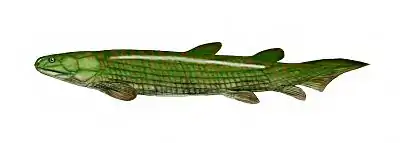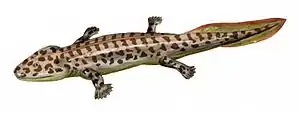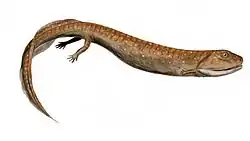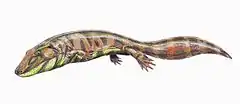Tristichopteridae
Tristichopterids (Tristichopteridae) were a diverse and successful group of tetrapodomorph fishes living throughout the Middle and Late Devonian. They first appeared in the Givetian stage of the Middle Devonian. Within the group sizes ranged from a few tens of centimeters (Tristichopterus) to several meters (Hyneria and Eusthenodon).
| Tristichopteridae | |
|---|---|
 | |
| Teeth of Platycephalichthys, in CosmoCaixa Barcelona | |
| Scientific classification | |
| Kingdom: | Animalia |
| Phylum: | Chordata |
| Clade: | Eotetrapodiformes |
| Family: | †Tristichopteridae Cope, 1889 |
| Genera | |
|
See below | |
Some tristichopterids share some of the features of the elpistostegalians, a diverse clade of fishes close to the origin of (and including) tetrapods.[1] This mainly concerns the shape of the skull and a reduction in size of the posterior fins.
An old and persistent notion is that Eusthenopteron was able to crawl onto land using its fins. However, there is no evidence actually supporting this idea. All tristichopterids went extinct by the end of Late Devonian.
Description
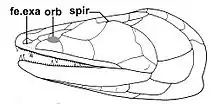

| The Tristichopteridae were medium-sized (Tristichopterus, 30 cm) to very large fishes. The smallest forms (such as Tristichopterus) attained lengths of 30 cm, and the largest forms (Hyneria) could grow several meters long, possessed teeth up to 5 cm long, and were the largest predators in their faunal communities.[2] The Tristichopteridae had a strongly developed fin skeleton, which probably enabled them to leave the water for short periods. In the skeleton of the front fins, which were deeply attached, the elements of the forelimb of the later tetrapodomorphs, such as the humerus, ulna and radius, can already be recognized. The parts of the bones directed outward from the body trunk were flattened. The pelvis had long, tapering pubic branches (pubic rami) that possibly met in a cartilaginous symphysis. The ventral fins also contained the major bones of the hind legs, femur, tibia, and fibula. Ankle bones (tarsal bones) and toes cannot yet be identified. The limbs were oriented to the side and could only be moved back and forth about 20 to 25°. The anal fin sat on a basal, fleshy peduncle. The caudal fin possessed three lobes, initially asymmetrical in basal forms and becoming more symmetrical externally in later forms. Only modern round scales with a median projection on the inner side, lacking a cosmine layer occurred in the family.[3]The earliest-known fossilised evidence of bone marrow has been found in Eusthenopteron, which may be the origin of bone marrow in tetrapods.[4]
The ontogeny of the Tristichopteridae is relatively well-known, and can be somewhat reliably inferred through Eusthenopteron.[5]Eusthenopteron differs significantly from some later Carboniferous tetrapods in the apparent absence of a recognized larval stage and a definitive metamorphosis. In even the smallest known specimen of Eusthenopteron foordi (at 29 mm), the lepidotrichia cover all of the fins, which does not happen until after metamorphosis in genera like Polyodon. This might indicate that Eusthenopteron developed directly, with the hatchling already attaining the general body form of the adult.[6]
Genera of Tristichopterids
Phylogeny
Below is a cladogram modified from Swartz, 2012.[1]
| ||||||||||||||||||||||||||||||||||||||||||||||||||||||||||
References
- Swartz, B. (2012). "A marine stem-tetrapod from the Devonian of Western North America". PLoS ONE. 7 (3): e33683. Bibcode:2012PLoSO...733683S. doi:10.1371/journal.pone.0033683. PMC 3308997. PMID 22448265.
- Thomson, K. S. (1968). "A new Devonian fish (Crossopterygii: Rhipidistia) considered in relation to the origin of the Amphibia". Postilla. 124.
- Zylberberg, L., Meunier, F. J. and Laurin, M. 2010. A microanatomical and histological study of the postcranial dermal skeleton in the Devonian sarcopterygian Eusthenopteron foordi. Acta Palaeontologica Polonica 55: 459–470.
- Sanchez S, Tafforeau P and Ahlberg P E (2014) "The humerus of Eusthenopteron: a puzzling organization presaging the establishment of tetrapod limb bone marrow" Proceedings of the Royal Society B: Biological Sciences, 281 (1782): 20140299. doi:10.1098/rspb.2014.0299
- Schultze, H.-P. 1984. Juvenile specimens of Eusthenopteron foordi Whiteaves, 1881 (Osteolepiform rhipidistian, Pisces) from the Late Devonian of Miguasha, Quebec, Canada. Journal of Vertebrate Paleontology 4: 1-16.
- S. Cote; R. Carroll; R. Cloutier; L. Bar-Sagi (September 2002). "Vertebral development in the Devonian Sarcopterygian fish Eusthenopteron foordi and the polarity of vertebral evolution in non-amniote tetrapods". Journal of Vertebrate Paleontology. 22 (3): 487–502. doi:10.1671/0272-4634(2002)022[0487:VDITDS]2.0.CO;2. ISSN 0272-4634.
- Ahlberg, PE and Z Johanson (2001). "Second tristichopterid (Sarcopterygii, Osteolepiformes) from the Upper Devonian of Canowindra, New South Wales, Australia, and phylogeny of the Tristichopteridae." in Journal of Vertebrate Paleontology 17:563-673.
- Johanson, Z. and P.E. Ahlberg (1997). "New tristichopterid (Osteolepiformes; Sarcopterygii) from the Mandagery Sandstone (Famennian) near Canowindra, N.S.W., Australia." in Transactions of the Royal Society of Edinburgh 88:39-53.


